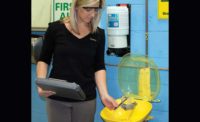With winter officially upon us, freezing temperatures can be expected across many parts of the country. In some areas, exceptionally cold weather will linger indefinitely, while other regions will experience freeze-thaw cycles.
If you haven’t already done so, take the time now to ensure your emergency equipment is ready for the cold weather, no matter how long it’s expected to last.
Frozen safety equipment that cannot be operated properly or at all will turn an emergency into a disaster. It’s precisely this scenario that drives many plant safety managers to inspect and re-inspect their respective emergency equipment environments all the more diligently at this time of year. While the best approach to ensuring that safety equipment is always in prime operating condition is with proper product installation, preventative maintenance and routine inspection and testing, there are other methods often taken to remedy emergency equipment prone to freezing.
If you live and work in an area where temperature stay below freezing for long periods of time, consider these approaches to keeping your emergency equipment operating properly.
The bury-valve
This approach has been used for years. It involves burying the actuation valve for the equipment beneath the frost line in the ground. A mechanical linkage connects the buried valve to a mechanical paddle or other method of point-of-use actuation. Also incorporated into this design is a pressure valve, which is located below the frost line as well, that releases all water above the pressure valve when it is not actuated. All water is left below the frost line until it is needed and remaining water is drained to the ground below the frost line once the equipment is turned off.
Electric heat-traced tape
A popular technology set these days involves the use of electric heat-traced tape wrapped around the pipes and emergency equipment componentry above the frost line. With this alternative, water is available instantaneously. While we’ve seen many examples of plants in which standard emergency equipment was modified by the use of heat-traced tape in an effort to make it freeze-proof, it’s not always a recommended approach.
Another method that can backfire involves “shade-tree” installations. In this set-up, steam pipes are run close to emergency equipment or emergency equipment supply pipes in an effort to prevent freezing. This presents two potential complications. Hot spots, or scalding hot water at the point of use, or freezing in areas not quite close enough to the warmth, both have the potential to create hidden problems.
What about parts of the country the occasional snap freeze is a likelihood? A range of anti-freeze valves is available to suit varying equipment. These valves turn on a trickle of water during a snap freeze to minimize the possibility of freezing.
While there is no way of knowing what winter has in store this or any year, failure to prepare can mean significant problems in an emergency. Maintain routine inspections and testing on your safety equipment, and consider alternatives that will ensure your plant’s ability to withstand freeze temperatures – just in case.






